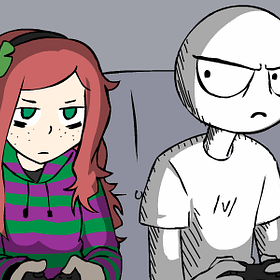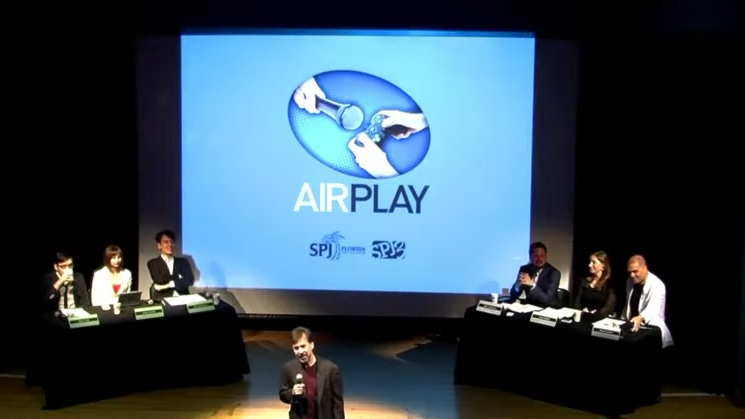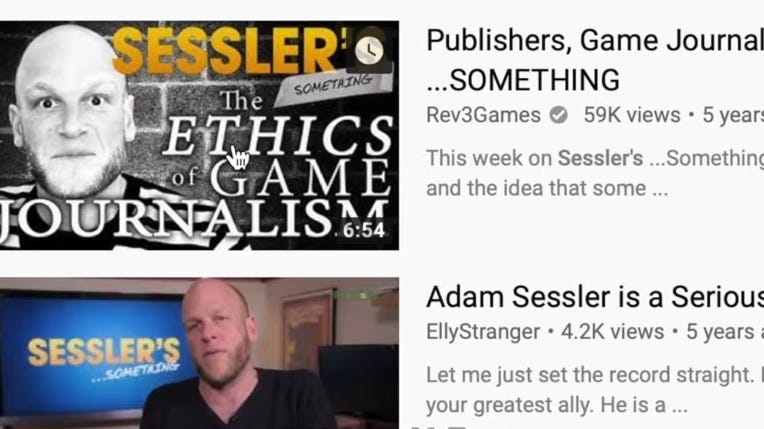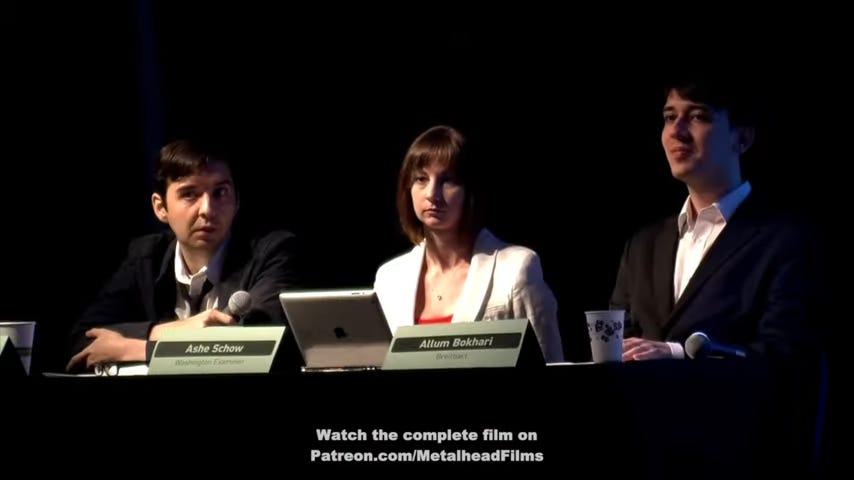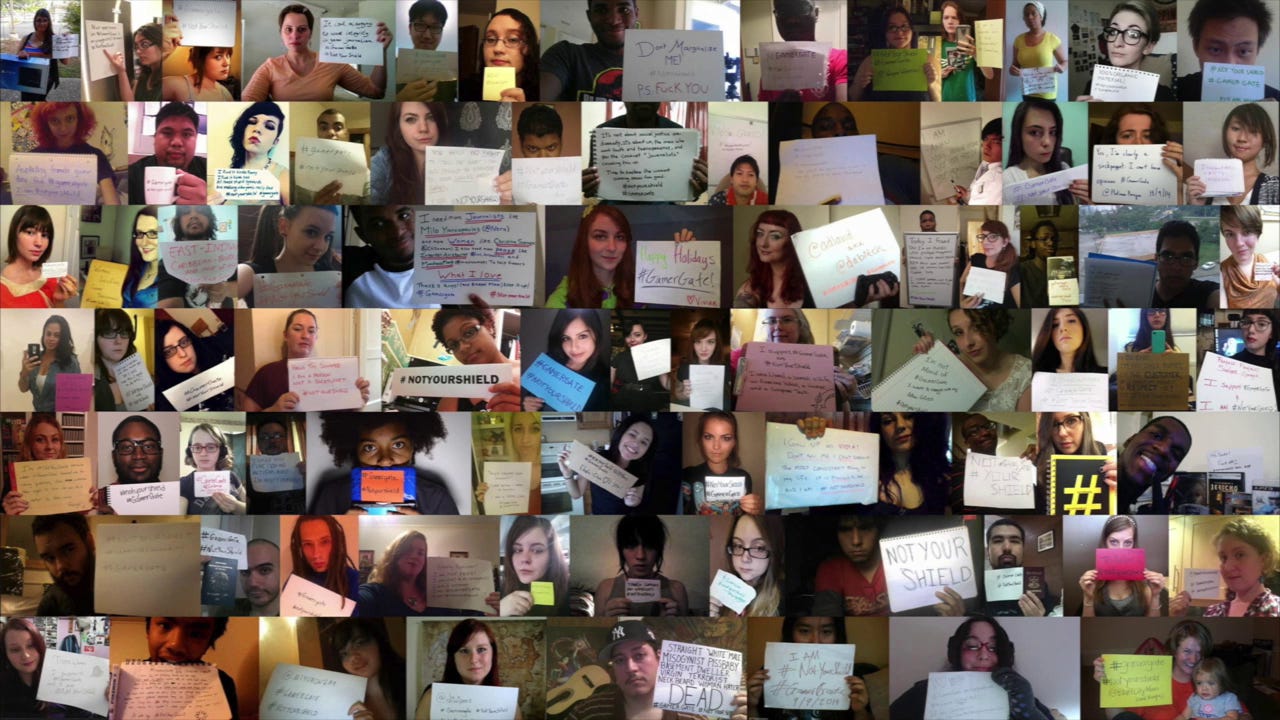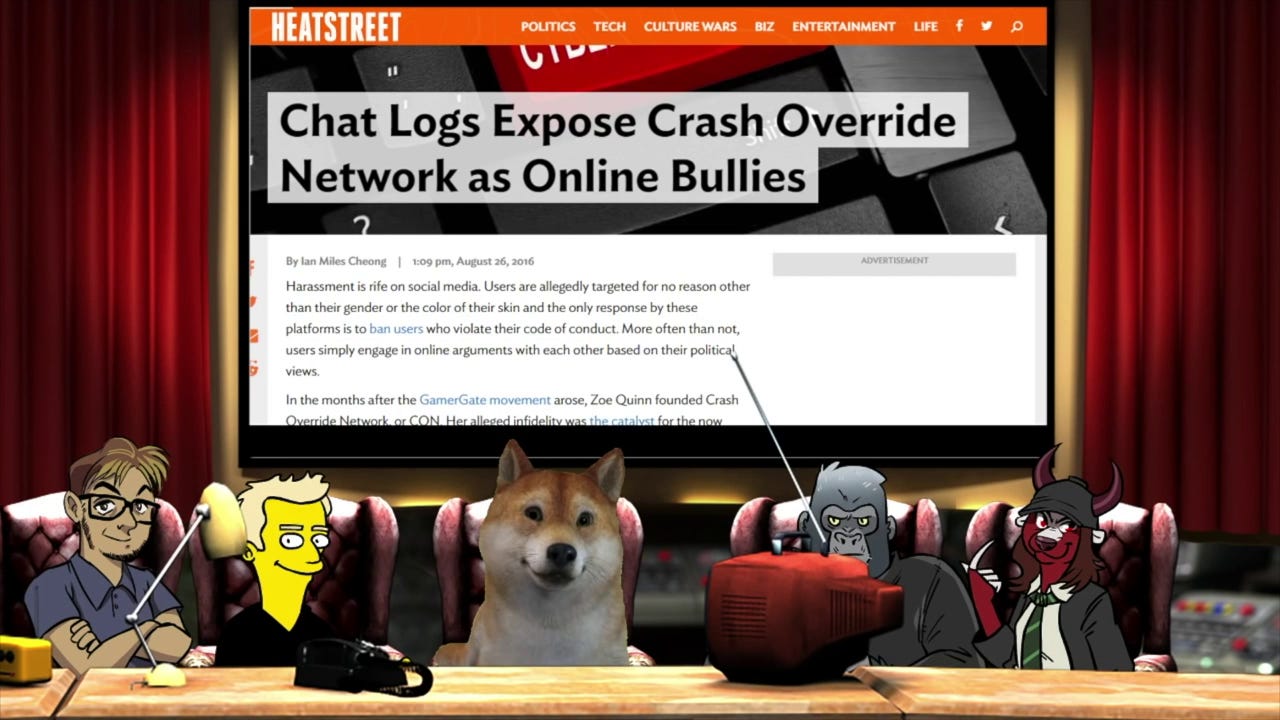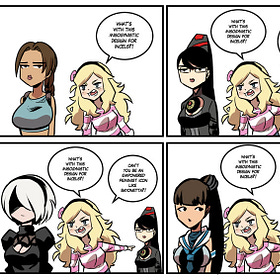Airplay: A Valuable Snapshot of Gamergate
What does Airplay offer to the overall discourse that others of its kind don’t? It’s a long story, but past the flaws lies a thoroughly-documented record worth seeing.
Disclaimer: The documentary in its full form was sent to the author by the filmmaker. Beyond this, there has been no prior relationship, nor any monetary and material connections involved. The first part is available for free on YouTube.
Whenever something like Gamergate is brought up, it can for better and worse, elicit either dismissive indifference or strong emotional responses. Yet over 10 years on, trying to explain what it was exactly, and why people ought to care, can be a challenge. Even the broad definition used by old supporters as a “reaction to an industry calling its customers racist,” as Youtuber PSA Sitch put it in a May 2017 video, doesn’t always provide an apt explanation. It’s amidst this confusion, plus the passing of time and well-poisoning by mainstream media platforms, that Metalhead Films’ Airplay enters the picture, which aims (and for the most part succeeds) at capturing the controversy and movement as a valuable snapshot of internet history that’s still relevant now as before.
An adaptation of writer James “Grim” Desborough’s book Inside GamerGate: A Social History of the Gamer Revolt (who’s also involved as the narrator), the documentary takes its title from an August 15, 2015 series of panels about the controversy and movement mediated by the Miami, Florida chapter of the Society of Professional Journalists. A string of ten bomb threats led to local authorities evacuating a whole city block later that afternoon, with the likes of future WIRED UK Contributing Editor Daniel Nye Griffins downplaying the affair as an “illuminating” if ultimately unpopular blip in an industry and a market moving away from the past to embrace a less reactionary future. The significance of the name, however, goes much further than trivia, with the two parts (comprising a runtime of almost five hours) echoing the “AM” and “PM“ sessions which transpired that day. As remarked by creator Raymond Wallman, a filmmaker from Long Island, New York who had worked on the project on-and-off from September 2017 to October 2022, it was something that needed to be done. “I didn’t like the way an entire population of people were being defamed,” he explained, “so I wanted to tell the true story.”
Even setting aside the pitfalls that tend to accompany longform video essays and those exploiting these for their own gain, one would be hard-pressed to find any exposes on the whole situation that delve deep into it. The Sarkeesian Effect, a 2015 documentary by Jordan Owen and Davis Aurini, was notably mocked across the board, even on the ardently pro-GG KotakuInAction subreddit. Whether due to myriad factual errors or being perceived as a thinly-veiled grift by its creators, not even its advertised interview with the infamous Jack Thompson saved it from sliding into obscurity. Meanwhile, Lance “The Serfs” Lanceras’ Gamergate: The Untold Story from 2021 was a sleekly produced feature-length Youtube video masking glorified narratives of sexism, harassment and bigotry. Its myriad talking heads (including games journalist Nathan Grayson) spending more of the runtime trying to find nebulous links with Pizzagate conspiracies, Donald Trump, and the January 6, 2021 Capitol riots, than actually discussing the subject itself.
The Culture Wars in Fandom through the lens of GamerGate
A cursory glance at social media on the contemporary discourse around video games is often enough to see the culture wars simmering within them. Within this sphere, among the most infamous manifestations is the GamerGate controversy.
With all that said, what does Airplay offer to the overall discourse that others of its kind don’t? It’s a long story, but past the flaws lies a thoroughly-documented record worth seeing.
Ethics in Journalism, With Clarity
The transformation of games media from its enthusiast, albeit biased press days would ring familiar to long-time gamers. By the mid-late 2000s, the growing influence of advertisers on outlets’ content (highlighted by Doritosgate and Gamespot editor Jeff Gerstmann being fired over a negative review), as well as the sort of clickbait mentality encouraged by Kotaku owner Gawker Media, fostered more scrutiny from both consumers and commentators on nascent platforms like YouTube. The nepotistic ties between writers and certain independent auteurs (notably Phil Fish and Anna Anthropy) observed in the early 2010s also led to gaming coverage taking on a more politicized and increasingly patronizing if not confrontational tone against their erstwhile audiences. All ultimately going back to ethics in journalism, which serves as a key overarching motifs of Airplay.
The documentary mimics the flow of topics discussed at its namesake as it unfolded, with over half of Part 1’s runtime focused on games journalism’s devolution and those involved. That lengthy discourse, however, does more than lay the groundwork for all else that follows, with Eron Gjoni’s now-infamous August 16, 2014 blogpost - which exposed independent game developer Zoe Quinn’s dalliances and conflicts of interest, including Grayson due to his work for Rock Paper Shotgun and later Kotaku - only broached 56 minutes in. Instead, it puts a fresh lens on what transpired amidst the growing media corruption before and during the immediate few months of the controversy. Whether it’s Colin Moriarty framing audiences’ passionate criticism over Mass Effect 3 as “entitlement” on March 2012, websites like Polygon lowering review scores for games like Bayonetta due to perceived sexism, or the “Gamers are Dead” hitpieces of August-September 2014 being as much as case of collusion as it was “social justice warrior” subversion, it underscores how much the gaming press played a role in bringing about a tinder box that ultimately caught fire as a movement.
All throughout Part 1, there’s a deliberate effort to mitigate the need for talking heads in the conventional sense, with Desborough’s narration filling in when needed. Instead, relevant clips from the SPJ event (many featuring lead organizer and regional head Michael Koretzky) are mixed in with news reports, social media entries, and commentary videos which are either directly linked to what’s being discussed or closely related enough to segue into it. “Since GamerGate was one of the first controversies to play out entirely online,” the filmmaker said, “there are hours worth of video online of people arguing over it. All the footage was already available, it just needed someone to assemble it.”
The editing in this segment, granted, could have used more fine-tuning, especially with how clips tend to drag for longer than necessary. Yet whether it’s those present back at the time - which included journalism ethics expert Lynn Walsh, indie developer Derek Smart, and then-Breitbart correspondent Allum Bokhari - or archival footage of figures as varied as Quinn, James “Internet Aristocrat/Mister Metokur” Augustine and (posthumously) John “TotalBiscuit” Bain, there’s a wide variety of views and commentary to parse through, much of which worth going back to for further study. There’s likewise no discrimination in what’s presented, be it dismissive remarks from some SPJ representatives regarding Kotaku’s antics due to Gawker’s questionable credentials, or Milo Yiannopoulos’ role in exposing the GameJournoPro mailing list being acknowledged despite his dubious motives in aligning with pro-GG supporters.
Put together, these not only give the audience a time capsule into a specific event, but also help paint a more wholistic, accurate, and most importantly, coherent portrait of how Gamergate came to be. There’s a sheer density of material on hand, including archived sources that are no longer readily accessible online - be it due to being scattered across disparate platforms, the hosted accounts not existing anymore, or deliberate censorship - though this can also result in the visual fidelity fluctuating wildly between grainy and high-definition. Yet at no point does Part 1 of Airplay feel unwieldy due to this grounded conceit, leaving it to viewers to make their own judgements. It’s perhaps the best-done part of the overall tapestry.
Chaos and Culture Wars
No conversation on Gamergate would be complete, however, without delving into the culture war aspects, being as much the subject of Part 2 as the SPJ afternoon session it thematically invokes. Whether it’s the role of activists like Anita Sarkeesian (of Feminist Frequency infamy) or the negative mainstream media coverage, this might make this section seem superfluous at best. Yet as chaotic as the 2015 panel in question played out - reflected not only by the growing back-and-forth not only between the SPJ and Yiannopoulos, pro-GG feminist Christina Hoff Sommers and sympathetic journalist Cathy Young (then working for Reason Magazine) - there’s still an effort by Metalhead Films to make sense of something easily lost in the cacophony, even though it comes close at points to falling into its own.
Take the way Sarkeesian and then-partner Jonathan McIntosh are approached, for instance. Though already criticized by gamers prior to 2014 for their questionable commentary and stolen content, the filmmakers make a convincing case on how they were circumstantial to the overall picture at first - whether through citing their own videos, or the likes of Sommers refuting their claims of fiction propagating reactionary and sexist ideas - outside of publications giving them gratuitous attention. They put themselves directly into the discourse, however, through a video hitpiece about the supposed “male privilege” in gaming on December that year, which also featured their connections with the industry and press (including Adam Sessler from the now-defunct G4TV), and drew in more of their “SJW” allies in the process. It’s this confluence of unethical journalist hijinks and ideological browbeating that also led to the emergence of #NotYourShield among female, minority and international supporters, who were dismissed as either a cover for white, male American bigots, or astroturfed “sockpuppets” to distract from tales of harassment and death threats.
Amidst myriad twists - from how claims of harassment were not just indiscriminately caused by trolls and bad actors, but also partly fabricated by some like Brianna Wu for self-promotion to the way memes and social media are used to irreverently counter narratives - Airplay also shows how the initial impetus remained intact. As much as the outrage against gaming echoed moral panics over the decades, the media’s role in propping up the likes of Feminist Frequency and scapegoating with which lawmakers could use to justify whatever draconian legislation they wish to pass (referred to as the “deviancy amplification spiral” by Wallman) is presented as a recurring constant. That intersectionality as invoked by them (often wrapped in obtuse rhetoric and summed up with “everything is political”) is functionally similar to yesteryear’s puritanism, whether it’s Thompson’s old crusades or those of Sarkeesian espousing similar rhetoric in progressive garb, is likewise emphasized. All throughout, ethics remained a central aspect unifying an erstwhile leaderless movement, even if this expanded past games journalism and the specifics were increasingly disputed.
“The panelists kept wanting to talk about culture war issues while [Koretzky] wanted to talk about ways journalists should cover online controversies like GamerGate,” Wallman remarks in hindsight, explaining Part 2’s more chaotic and contentious tone compared to Part 1. Aside from SPJ representatives questioning whether discussing SJWs offered anything valuable for mainstream journalists, or comparing Yiannopoulos’ informal and opinionated approach in covering pro-GG communities with that other sympathetic reporters like Brad Glasgow, those growing rifts manifest themselves in myriad other ways as Airplay progresses.
The way topics jump from one point to another - such as tying the role intersectionality played in Occupy Wall Street’s deterioration to how members of academic groups like the Digital Games Research Association (DiGRA) were intertwined with the “Gamers are Dead” articles - can seem less focused, if not more disjointed, giving a taste of how the flow of ideas must have been in Miami. Yet from providing additional narration from Desborough and thematically relevant sources from well after 2015, to covering as many angles within the panel’s framework as possible, the overlapping (and more often than not mutually “beneficial”) ties between opportunistic ideologues and unethical journalism are shown to be materially grounded. Instead of speculative presented with such detail that long-time observers and newcomers alike might learn new details on otherwise familiar talking points (such as why skepticism of figureheads led to a very decentralized structure). One catches here a glimpse of the movement’s heyday as it was in practice, warts and all.
These all contribute to Part 2 running at almost three hours long, however. In addition to editing issues carried over from Part 1, the penchant for segues into controversies like #CancelColbert in 2014, the dubious media handling of the 2020 Black Lives Matter protests, and online personality Carl “Sargon of Akkad” Benjamin being falsely accused by Sarkeesian of harassment at VidCon 2017 come across as redundant. The decision to not just discuss how the SPJ I(and Koretzky in particular) came to cross paths with Gamergate on social media, but also contextualize observed overlaps with the wider culture wars in the West - from mainstream outlets finding excuses for lumping gamers alongside Trump supporters as “Alt-Right” propaganda, to how younger conservatives were inspired to use irreverent humor like “Kekistan” to mock “woke” politics - also drag out the pacing. Echoing comments from the 2015 panel by NBC San Diego representative and SPJ member Lynn Walsh, there’s so much on hand and so little time for her (and by extension viewers) to draw attentio. This could have been better served split up in more bite-sized pieces, if not a miniseries.
Yet after going through both the documentary and sources - including references to Saul Alinsky’s Rule for Radicals: A Pragmatic Primer for Realistic Radicals, as applied by gamers against journalists and activists alike - there’s little found that could really be called conspiratorial or agenda-pushing in the same manner as The Sarkeesian Effect. That the filmmakers acknowledge how the leaderless nature of Gamergate confounded SPJ speakers on how to approach it, gives more ample screentime to anti-GG archival footage, and admits how the turmoil the afternoon session owed as much to the panelists present - specifically, highlighting how Yiannopoulos’ attempts to steal the limelight from Sommers and Young contributed to that confusion and betrayed his more egotistical aspirations which would meet back lash from pro-GG communities like KotakuInAction down the line - as the topics themselves is commendable. If nothing else, Airplay is anything but one-sided.
Threats and Victory
For much of Airplay, little’s mentioned of how anti-GG critics had vocally boycotted the namesake event, as noted by Koretzky during the leadup over the course of 2015. Neither are the infamous bomb threats that led to the event’s evacuation mentioned for much of Part 2’s runtime. That the incident itself barely made headlines outside some online outlets and local papers, while others mocked the entire affair a failure, was no less significant. This shapes how the documentary covers the other elephants in the room, but also how it the discussion being followed is ultimately resolved.
From industry organizations like the International Game Developers Association (IGDA) abusing autoblocking tools as impromptu blacklists to the way media outlets framed the common cause some gamers made with men’s rights activists against those in games media pushing regressive forms of feminism as proof of a sexist male plot, it’s made clear that whatever pretenses towards fairness were never so much as considered. Meanwhile, with the likes of “Crash Override Network,” an support group founded by Quinn from 2014 to 2016 meant to fight online harassment, being used instead as a platform to instigate it (as revealed in leaked chatlogs by former members like Ian Miles Cheong), it reinforced the view that such journalists and activists were seeking to intimidate, if not harm anyone who dared speak out against them, all the while playing up victimhood for their press allies to publish.
The collusion with Feminist Frequency, as well as how myriad analyses (including a 2015 study by non-profit organization WAM!) pointed to the majority of confirmed, substantiated harassment coming from anti-GG circles just adds to the proverbial insult to injury. Driving that contempt deeper, former Jeopardy! champion-turned-writer Arthur Chu attempted to have a May 2015 meetup among prominent pro-GG figures at a bar in Washington, DC shut down, inspiring unknown parties to make credible bomb threats to the venue. Though these were eventually found to be false, it proved to be foreshadowing for the SPJ event, with something similar happening some 30 minutes before the afternoon panel was scheduled to end. Even the documentary itself seemed to stop in its tracks briefly at that moment, as though to drive that point home.
Even amidst such hurdles, looks could be deceiving. As recounted by Gawker editor Max Read in an August 2016 New York Magazine feature, not only was the movement listed among the reasons for the media company’s bankruptcy (alongside Hulk Hogan and Peter Thiel), but explicit called it and its penchant of contacting advertisers as major threats. This extended to less compromised elements within games journalism itself, with a 2021 podcast between freelance writer Erik Kain and the same Moriarty who penned (and having since regretted making) the 2012 Mass Effect 3 hitpiece notably highlighting how the latter admitting that pro-GG was right to call out such misbehavior. Indeed, a few months after the SPJ panel, the Federal Trade Commission released stricter guidelines on native advertising (especially with regard to video games), with far-reaching repercussions across the internet. All the while, many outlets began implementing updates to their own ethical standards (notably more visible disclosures), with various culprits either leaving the stage willingly or being fired.
That both the panelists and the attendees, largely through both old and rarely-seen HD footage, who stayed and continued conversations among themselves even after the bomb threats, is just as significant. It seemed to reaffirm Derek Smart’s views on gamers as a genuinely diverse and committed lot, with the movement they represented as a celebration of free thought. It also seemed to convince Koretzky - who managed to both keep the event going, and also conduct the closing remarks outside in the Miami heat - admitting in the end that it was worth it, something he would repeat with little hesitation as recently as July 2024.
Despite everything, Gamergate had won, and it’s a point Airplay sells persuasively in spite of itself. Yet it’s a story not quite over.
A Valuable, Relevant Reminder
While non-partisan commentators like Jonathan Haidt have argued that Gamergate marked the first battle of the current culture wars, as he remarked in an April 12, 2022 podcast with Bari Weiss, it’s can seem tempting to write all it off as history. Some of the people cited as sources from either side of the controversy have slid into irrelevance if not extremism and disrepute, with some like Yiannopoulos and Chu falling harder than others. Yet conversely, some of those directly implicated in unethical hijinks have either not learned a thing or feign willful ignorance, as seen with it’s Grayson (who had moved from Kotaku to the Washington Post over the interim) using his now-independent journalist pretensions to push smears on companies like Valve for political grandstanding. Meanwhile, former Feminist Frequency members (including Sarkeesian herself), bereft of the press’ attention due to slipping out of the deviancy amplification spiral they once benefited from, have pivoted towards consultancy to make deeper inroads into the industry, intertwining with both growing concerns over DEI/ESG and censorship that boiled over into a “sequel” breaking out on February 2024.
Gamergate 2.0 at the Crossroads
Much has been written about Gamergate 2.0 since February 2024 by various people on every side, myself included. Having become a mainstay in gaming discourse, it’s become difficult if not borderline impossible to ignore even so much as indirect mentions of it, be it out of derision or otherwise. Tensions within and beyond, however, have put the nascent m…
According to Wallman, much of the blame for the increasingly volatile gaming landscape can be placed on the same sorts of journalists - many of whom ironically reflect a monoculture dominated by urban dwelling, college educated populations - who still find it expedient to stoke the proverbial flames. “They have found it more profitable to cater to a small niche population than it is to cater to a broad swath of the population,” he says. “Now with the internet it is possible to have news reporting skewed in favor of any population they wish.” This logic can work both ways, as those alienated by such an environment risk drifting toward a similar but opposite ideological rigidity, exacerbating the culture wars further. These, coincidentally, make a documentary like Airplay more than just as a valuable, time capsule on what Gamergate was, however flawed in execution. It’s also a poignant reminder of how relevant it still is.
That the press not only continues to invoke anti-GG agitprop long after the fact (making the likes of Gamergate: The Untold Story reiterating the same old narratives all the more ironic) but scapegoat it for whatever’s deemed problematic at any given moment reveals how even the mere mention of “ethics in journalism” still has the power to unnerve. Games sites like IGN, Polygon, and Rock Paper Shotgun have come to be seen as “legacy media” in much the same vein as the New York Times, many instead looking to streamers and Youtubers. Moreover, the push for better standards continues to reverberate in the way those same content creators are judged by their integrity rather than who they know, while the diffused nature of online commentary makes it easier to just isolate persons or organizations who act unethically without compromising the whole. Which is not to ignore the repeated determination and persistence of gamers amidst adversity, whether against DEI/ESG advocates, bad actors in the industry itself, or culture warriors on either side trying to drag everyone down with them into the abyss.
Perhaps, as Koretzky suggests, historians will one day judge the movement more fairly. Whether or not the documentary persuades critics along such lines, however, it calls to mind the archived comments of Oliver Campbell, an independent journalist-turned-streamer who, though dropping out from being a panelist over scheduling issues participated as an attendee back in 2015. Despite previously working in the same circles as those who happily parroted “Gamers are Dead” (having contributed to Kotaku and The Escapist), he‘s ostracized and smeared by his peers all the same, simply for reaching out to pro-GG communities. Yet in a podcast interview with Honey Badger Radio a few months before the SPJ event, he gave a speech which, while mocked at the time as hyperbolic, seems prescient in hindsight. As he put it, “We are gonna start seeing a lot of other people trying to catch up and go: ‘Why is it that a gamer can sit down and say what they said, and do so bravely? With valor? Why am I not doing it?’”





